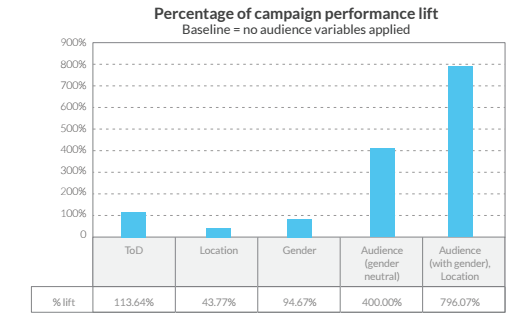Good marketers know that personalizing content and messaging is rapidly becoming table stakes. So much so, our recent research on personalization shows that targeted messaging can have a 200 percent lift on conversions over more general content. But there are real challenges in harvesting that data and putting it into action, especially on mobile.
With the general state of confusion and lack of maturity in the mobile ad market, it’s fair to question just how valuable targeting data can be and, more importantly, what you’re going to get back for using it.
How much lift can you get from targeting?
In one example in our recent research report on brands and mobile ads, Opera Mediaworks, which serves 90 percent of the top global advertisers, found the following lift when targeting these specific variables:
• Location: 43.77 percent
• Gender: 94.76 percent
• Time of day: 113.64 percent
• Custom audience (no gender, no location): 400 percent
• Custom audience (with gender and location): 797.07 percent

AI Weekly
The must-read newsletter for AI and Big Data industry written by Khari Johnson, Kyle Wiggers, and Seth Colaner.
Included with VentureBeat Insider and VentureBeat VIP memberships.
In other words, there’s massive opportunity to be had with proper data targeting in mobile advertising.
Join us at MobileBeat — the premier event for mobile marketing and growth — to learn more about mobile marketing, data targeting and acquisition, video advertising, and more from some of the world’s biggest brands on July 13 — 14 in San Francisco.
Targeting is something that is clearly critical in mobile advertising. And, if you’re getting the right data, targeting has a compounding effect as you continually narrow down to the exact audience that wants and needs the product you’re marketing.
Targeting examples:
- List-based targeting
- Address-based targeting
- Voting districts
- Historical data
- DMP-supplied third party
- Political views
- Geotargeting
- Previous location history
- Age
- Gender
- OS type
- Day parting (hours of the day)
- Category-specific
- Mobile web vs. in-app
I spoke with Ninja Metrics yesterday, and their CEO Dmitri Williams was able to show me, using technology in development for over 10 years with the CIA and NSA, how “social value” — which calculates the quantifiable effect we have on one another as friends, family members, or coworkers regarding purchasing decisions — can also serve as an ad targeting metric like those listed above.
While it’s common for insights or analytics companies to apply algorithms to determine customer personas (e.g., 18-21 year old males who watch Game of Thrones), Ninja Metrics looks a layer deeper at the individual level on whatever data it can mine: the shows you watch, clothes you buy, etc. — and calculates causality in how you affect those connected to you with your purchasing decisions. They’re claiming 85 percent accuracy with 400 million consumers having gone through their system. That’s a powerful targeting metric.
“I may see that a user spends five bucks a month but causes $1,000 per month of spending across that person’s network,” Williams said. “And if I know he’s likely to leave [the app], that’s very actionable information for marketers and advertisers.”
In two weeks, we’ll be exploring mobile data personalization, among several other topics to help business prepare for and act on the hypergrowth of mobile, at VB’s own MobileBeat. Join us on July 13 and 14 in San Francisco to learn from the best and brightest in mobile today.
VentureBeat's mission is to be a digital town square for technical decision-makers to gain knowledge about transformative enterprise technology and transact. Learn More
